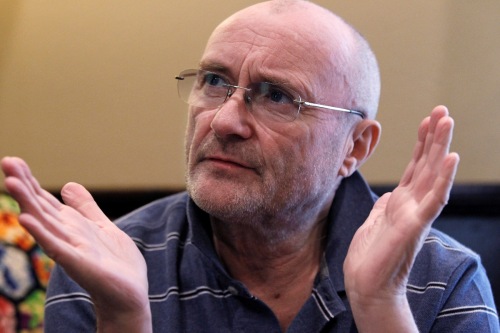Singer Phil Collins’ latest gig: collector of Alamo artifacts
By Claire LeePublished : May 18, 2012 - 18:59
Sandwiched between two respected Texas historians on a hard church pew, the compact Englishman looks nervous, stroking his stubbled chin as he eyes 60 or so people crowded into the Buffalo Gap Chapel waiting for the sound of that voice they couldn’t have escaped hearing over the last 40 years.
Never mind that he’s performed before crowds a thousand times bigger, sold a gazillion records, won Grammys and an Academy Award. British singer and drummer Phil Collins is fidgeting because he’s about to give the world a first glimpse inside his own private Alamo.
And it’s a rarefied and improbable realm, filled with hundreds of Texas Revolution artifacts and documents painstakingly archived inside a basement room in Collins’ home outside Geneva.
Rock stars are known for burning cash on Ferraris, yachts or trophy girlfriends. Collins? He never forgets the Alamo.
“It keeps me off the streets. What am I going to do? I don’t want to traipse around the world anymore,” he said. “I love it. I sit downstairs in my basement and looking at and sort of drooling over what I’ve got. It was never my intention to have this huge collection, but one thing led to another and it’s my private thing.”
Among his treasures are one of Davy Crockett’s rifles and his post-death receipt from the Texian Army. They share space with Jim Bowie’s knives, verbose William Barret Travis’ letters, Santa Anna items and a snuffbox that Sam Houston gave to a romantic interest.
And that’s just some of the pieces from the Texas Revolution’s big guns.
Perhaps more revealing about the depth of Collins’ obsession are the hundreds of historical bits ― buttons, dice, letters, weapons and IOUs ― linked to the less-celebrated defenders who died at the Alamo or the hundreds of anonymous Mexican soldiers who died with them on March 6, 1836.
The private event last week at the Buffalo Gap Historic Village’s 1903 chapel was the rehearsal for a five-day Texas tour to promote Collins’ expansive new book, “The Alamo and Beyond, A Collector’s Journey.”
The 384-page book, ($120 or $74.99 online), published by the tiny State House Press based in Buffalo Gap, includes illustrations by another Alamo buff, Gary Zaboly, and photographs by Ben Powell of Austin. Essays by Alamo curator Bruce Winders and McMurry University professors Don Frazier and Stephen Hardin lend academic heft and a historical backdrop to Collins’ personal stories about the individual artifacts.
“It’s not ghost-written ― he wrote every word,” said Hardin, author of “Texian Illiad: A Military History of the Texas Revolution.”
Collins’ relics are believed to make up the world’s largest private collection of such artifacts, said Frazier, who also manages State House Press, a nonprofit publisher of Texas history and Civil War books.
“This guy is brilliant. Phil’s not just a serious collector; he’s a scholar narrowly focused on the four months of the Texas Revolution,” said Frazier.
It’s no surprise to Winders that an Englishman would be captivated by the Alamo. The fight for freedom speaks to people worldwide, he said.
“The fact that you have a rock star who has a love affair with it says it’s everybody’s Alamo,” Winders said, noting that the San Antonio shrine draws nearly 3 million visitors annually.
Like legions of American kids in the 1950s, Winders was introduced to the Alamo by Walt Disney’s “Davy Crockett, King of the Wild Frontier” TV series.
An ocean away, in the London suburb of Chiswick, 5-year-old Phil Collins, who just got his first drum set, was enthralled by Fess Parker’s Crockett character, too. Hooked, he eagerly waited for John Wayne’s 1960 epic “The Alamo” to arrive in London, and he watched it repeatedly. And, of course, he had a coonskin hat.
Never mind that he’s performed before crowds a thousand times bigger, sold a gazillion records, won Grammys and an Academy Award. British singer and drummer Phil Collins is fidgeting because he’s about to give the world a first glimpse inside his own private Alamo.
And it’s a rarefied and improbable realm, filled with hundreds of Texas Revolution artifacts and documents painstakingly archived inside a basement room in Collins’ home outside Geneva.
Rock stars are known for burning cash on Ferraris, yachts or trophy girlfriends. Collins? He never forgets the Alamo.
“It keeps me off the streets. What am I going to do? I don’t want to traipse around the world anymore,” he said. “I love it. I sit downstairs in my basement and looking at and sort of drooling over what I’ve got. It was never my intention to have this huge collection, but one thing led to another and it’s my private thing.”
Among his treasures are one of Davy Crockett’s rifles and his post-death receipt from the Texian Army. They share space with Jim Bowie’s knives, verbose William Barret Travis’ letters, Santa Anna items and a snuffbox that Sam Houston gave to a romantic interest.
And that’s just some of the pieces from the Texas Revolution’s big guns.
Perhaps more revealing about the depth of Collins’ obsession are the hundreds of historical bits ― buttons, dice, letters, weapons and IOUs ― linked to the less-celebrated defenders who died at the Alamo or the hundreds of anonymous Mexican soldiers who died with them on March 6, 1836.
The private event last week at the Buffalo Gap Historic Village’s 1903 chapel was the rehearsal for a five-day Texas tour to promote Collins’ expansive new book, “The Alamo and Beyond, A Collector’s Journey.”
The 384-page book, ($120 or $74.99 online), published by the tiny State House Press based in Buffalo Gap, includes illustrations by another Alamo buff, Gary Zaboly, and photographs by Ben Powell of Austin. Essays by Alamo curator Bruce Winders and McMurry University professors Don Frazier and Stephen Hardin lend academic heft and a historical backdrop to Collins’ personal stories about the individual artifacts.
“It’s not ghost-written ― he wrote every word,” said Hardin, author of “Texian Illiad: A Military History of the Texas Revolution.”
Collins’ relics are believed to make up the world’s largest private collection of such artifacts, said Frazier, who also manages State House Press, a nonprofit publisher of Texas history and Civil War books.
“This guy is brilliant. Phil’s not just a serious collector; he’s a scholar narrowly focused on the four months of the Texas Revolution,” said Frazier.
It’s no surprise to Winders that an Englishman would be captivated by the Alamo. The fight for freedom speaks to people worldwide, he said.
“The fact that you have a rock star who has a love affair with it says it’s everybody’s Alamo,” Winders said, noting that the San Antonio shrine draws nearly 3 million visitors annually.
Like legions of American kids in the 1950s, Winders was introduced to the Alamo by Walt Disney’s “Davy Crockett, King of the Wild Frontier” TV series.
An ocean away, in the London suburb of Chiswick, 5-year-old Phil Collins, who just got his first drum set, was enthralled by Fess Parker’s Crockett character, too. Hooked, he eagerly waited for John Wayne’s 1960 epic “The Alamo” to arrive in London, and he watched it repeatedly. And, of course, he had a coonskin hat.

The Alamo story “changed my life,” said Collins, who has retired from the music business because of medical problems associated with years of flailing on the drums.
Thoughtful, polite and studiously serious about his passion, Collins, 61, said his interest in the Alamo has never waned.
“I never lost the passion for it. I just never dreamt of making a collection of it,” he said. “I had no inclination that I was going to make a lot of money, which is of course necessary if you want to collect.”
He first visited the Alamo in the early 1970s during a break while touring with Genesis. Then, in the late 1980s, he was browsing in an antiquities store when he came across a letter signed by Crockett that he thought was too expensive at $60,000.
“That was the point I realized, my God, this stuff exists,” he said.
Collins is thrice divorced, with five kids, including two young sons still at home. His collection started with a present from his third wife, a receipt for a saddle owned by John W. Smith, one of the couriers Travis dispatched from the Alamo.
“I thought if that’s out there, then let’s see what else is out there,” he said.
On his 2004 final farewell tour, Collins had a few days off after a show in Houston. He visited the Alamo a second time, thinking it might be his last chance before he focused on raising his boys.
After a private tour, he ventured into The History Shop, which sells historic maps, books and artifacts, and inquired about Alamo items. Owner Jim Guimarin was skeptical at first, but the men stayed in touch, “got on better,” and Guimarin started to locate artifacts, Collins said.
With Guimarin and former Alamo curator and historian Sam Nesmith “proving up” the authenticity of the items offered by dealers, relic hunters and families, Collins’ collection is still growing.
It includes the leather shot pouch and two powder horns that Crockett supposedly gave to a Mexican officer before he was executed and the sword belt that Travis might have been wearing when he died.
Collins won’t pick a favorite, but Frazier says he’s most impressed with the documents in the collection. But he says grasping Bowie’s knife is “like holding Excalibur.”
One day “over a few margaritas,” Collins and Guimarin started talking about what might be under Guimarin’s rented storefront. They bought the building, rented another shop space and organized a dig in 2007.
“I made it possible because I don’t buy Ferraris,” Collins said.
At a depth of 40 inches, “battle level,” they found hundreds of relics, including a rusted over-and-under pistol, musket balls and grapeshot, as well as personal items like buckles, buttons and a penknife.
“It was incredibly exciting. We found hundreds of horseshoes, but we found things that were in incredible condition,” Collins said, adding that he got an irate letter from an archaeologist about the dig.
“She thinks we just went in there with a spade. Nope, it was very well-organized, and everything was looked over,” he said.
Historic relics can be a touchy subject in more ways than one. There have been reports of talk among collectors that Collins was flimflammed on the Travis belt. He bristles at such speculation.
“I’m tired of reading about that stuff. I’m not gullible, I don’t buy everything I’m offered, and I’m advised not to buy some things I think I might like,” he said.
He also bristles at reports savaging him for his supposed belief that he was at the Alamo in another life.
“I never said I was at the Alamo. Someone else said I was at the Alamo. Now I’m a nutter. I don’t think that’s fair,” he said.
Hardin, who was an adviser on John Lee Hancock’s 2004 film “The Alamo” (which Collins still watches), said there were many discussions about the provenance of relics as the book progressed.
“That’s why in the book we have Travis’ sword with question marks,” he said. “On the other hand, I think we sometimes get hung up on the relic aspect. What we can learn from a shot pouch that belonged to Davy Crockett isn’t really that different from one that belonged to anybody else. So whatever they are, they are for sure really good artifacts that provide us a window into a lost world.”
Hardin and Frazier won’t hazard a guess on the value of Collins’ collection. But at Collins’ stratospheric level of collecting, it helps “if you are richer than God,” Hardin said with a laugh.
“Understand, he was bidding against some world-class museums and he got the items,” he said. “We’ve never talked money with Phil. I think he considers it tacky to talk about how much he paid for an artifact. I think he believes it’s not anybody’s business.”
Collins is already thinking about the collection’s future.
“There can’t be more than two dozen people who have seen it,” he said. “It’s mine, but the pieces will be going somewhere else, I hope as a collection.”
By Steve Campbell
(McClatchy Newspapers)


















